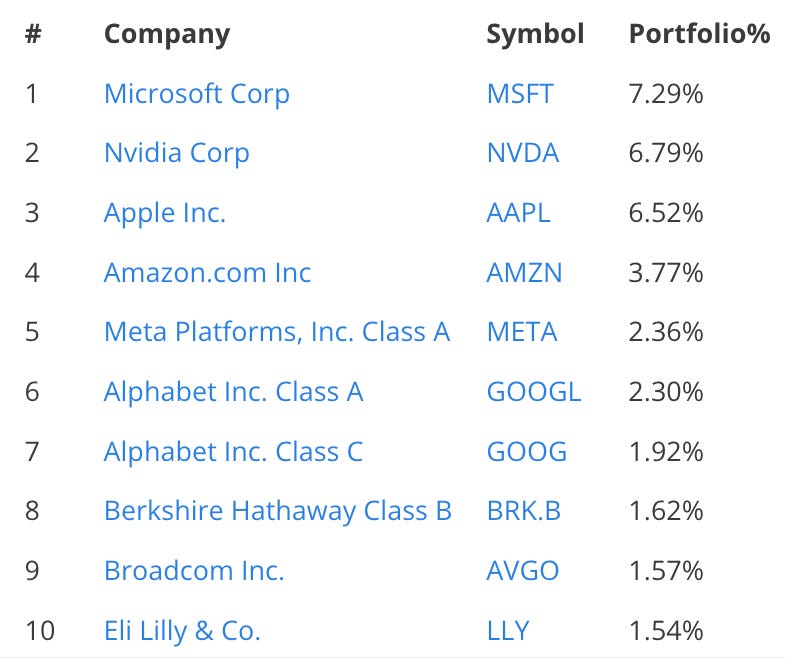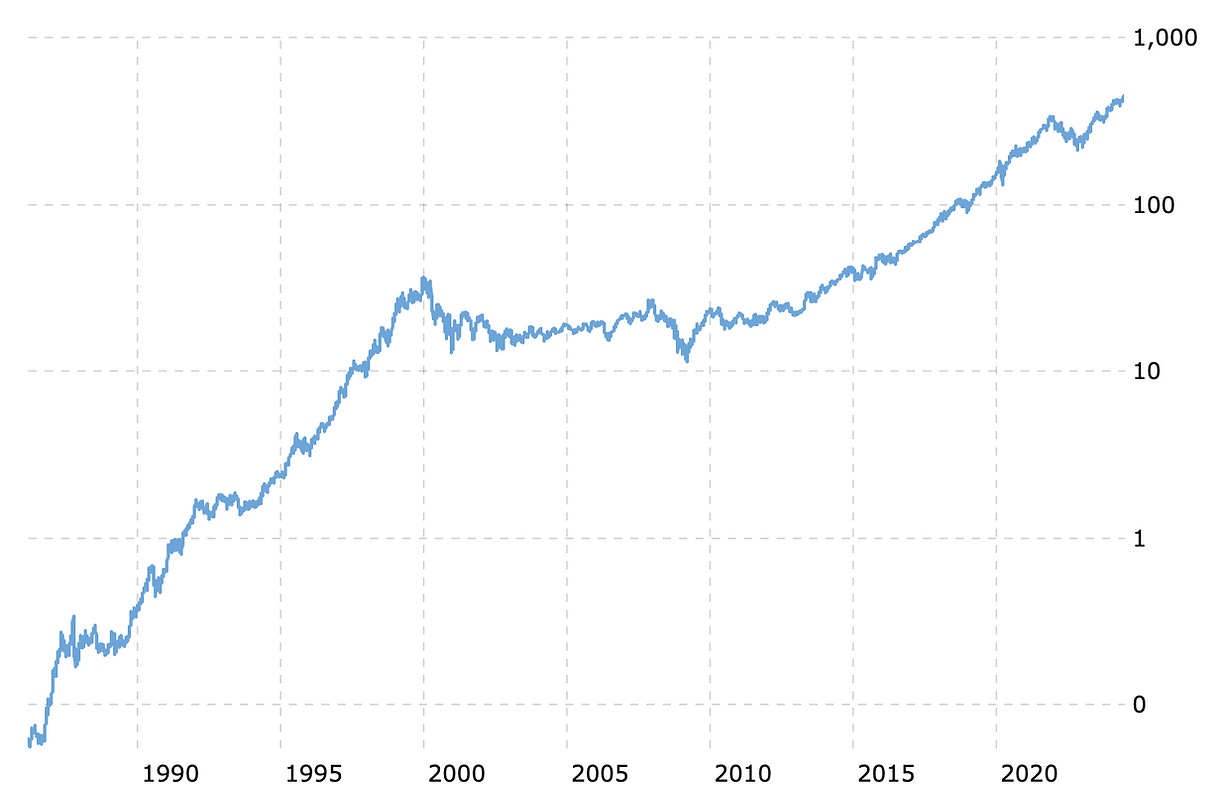How dangerous is Wall Street's extreme concentration on Nvidia, Microsoft and Apple?
The stock market is more concentrated today than at any other time in the last 100 years, except during the Great Depression. What does that mean?
It is now common knowledge among most investors that not only the Nasdaq 100, but also the S&P 500 Index owes its continued soaring performance primarily to the "Magnificent 6", i.e. the rise in value of Nvidia, Microsoft, Apple Alphabet, Meta and Amazon.
The performance of these 6 big tech giants, especially Nvidia, over the last 6 and 12 months is simply breathtaking:

Equally breathtaking is the place that the Magnificent 6 now occupy in the vast expanse of the S&P 500 Index. As a reminder, the S&P 500 contains the 500 most valuable US companies, weighted by market capitalisation (of free float).

The aforementioned Magnificent 6 alone now account for 31% of the market capitalization of the S&P 500.
Many investors find this worrying and wonder whether this reliance on individual companies is necessarily indicative of a major downturn in the market as a whole.
The top 10 US stocks now account for 37% of the market capitalization of the S&P 500 index, the highest concentration in decades. Even the 27% concentration reached at the height of the Dotcom bubble in 2000 has been surpassed.
To be fair, however, profits in the index have never been as concentrated in the top 10 stocks as they are today. Whereas in 2000 the top 10 accounted for just 15% of the S&P 500's earnings, this figure has now risen to over 25%.

So is there any reason to believe that high market concentration is a sign of an imminent sharp fall in the stock market?
Extreme stock market concentration is temporary
The following chart from a Goldman Sachs study shows the market capitalization of the most expensive company compared to the 75th percentile as an indicator of market concentration. This is the value that 25% of the companies in the S&P 500 are above and 75% of the companies are below.

Microsoft, Nvidia and Apple are now around 800 times more expensive than this benchmark. This is an extreme value that has only been seen once before in the last 100 years, at the end of the Great Depression in 1932.
Perhaps the most important takeaway from this chart:
Over the past 100 years, there have been several severe outliers in market concentration, similar to what we are seeing today with Microsoft, Apple and Nvidia.
This high concentration has ALWAYS been corrected relatively quickly; the high market concentration of individual stocks has NEVER lasted!
But how should these events of extreme concentration and their unwinding be seen in the context of the US market as a whole?
Is a bear market inevitable?
A look at the history of the S&P 500
The first peak in market concentration in 1932 coincided with the global economic crisis triggered by the stock market crash of 24 October 1929. At the end of a year-long bear market, investors wanted to buy only perceived safe stocks, and small caps were grossly undervalued.
When the market concentration disappeared after 1932, a bull market followed until 1937 with a 400% rise in the S&P 500!

However, there are also some examples where the unwinding of high market concentration actually coincided with a bear market.
In the years after 1973, the US experienced a long period of economic weakness and several recessions until 1982 (shaded grey in the chart above). High inflation was fought with interest rates of 10-20%. Not surprisingly, a long bear market began in 1973. The S&P 500 Index lost more than half its value by 1982.
Market concentration: the example of IBM
The dominant technology company at the time was IBM, which had a market capitalization of around 6-7% of the S&P 500. This is very similar to the weighting of Microsoft, Apple and Nvidia today.
Between 1987 and 1993, IBM lost two-thirds of its value, and the extreme market concentration on the part of IBM dissolved. Before that, however, the share price had risen by 200% between 1981 and 1987, following the launch of the IBM PC.
Market concentration in the Dotcom bubble
Those of you who are older will remember the year 2000 well. At the end of the 1990s, the invention of the Internet had led to the famous Dotcom bubble.
At the time, the shares of all companies that did "something" with the internet rose for years. Many of the business models were not viable, but investors simply ignored this for a long time.
Then came the great awakening that was bound to happen: the bubble burst and the S+P 500 lost half its value by the end of 2002. The Nasdaq-100 index lost more than 75%!
Market concentration: the example of Microsoft
The world's most valuable company in 2000 was once Microsoft. In fact, the Redmond giant is the only tech company in the top 10 that is still in or back in the top 10 almost 25 years later.
However, even though it looks harmless on a logarithmic chart, Microsoft's long-term shareholders have been through a lot: Between 2000 and 2009, Microsoft lost two-thirds of its value, and the high concentration dissolved.
Market concentration: the example of Cisco
The situation was even worse for Cisco shareholders, who were among the most valuable companies in 2000, along with Microsoft and General Electric.
At the time, Cisco's networking components dominated the infrastructure of the emerging Internet, making it the leading "shovel seller" for the construction of the Internet. From 1995 to 2000, Cisco's share price rose by 4,000%.
From 2000 to 2002, as the Internet hype subsided, Cisco's stock lost about 90% of its value. Although the Internet changed the world and Cisco remained the clear technology leader for years. The networking giant's shares are currently trading lower than they were in 2000.
Conclusion
Today's high market concentration of Big Tech has increased investor concerns that a sharp decline in the largest stocks will lead to a market downturn.
However, history does not suggest that the unwinding of extremely high market concentration will necessarily lead to a general bear market. Rather, history shows that "catch-up" phases of smaller stocks are just as common as general "down" phases. Nothing is certain ;-)
What seems inevitable, however, is that the historically high market concentration in Big Tech will disappear in the coming years. My conclusion is that selected Small and Mid Cap stocks still have a right to exist and will catch up during this phase. In other words: VALUATION MATTERS!
Unless the big tech bulls are right and the AI megatrend is different from all the other technology leaps of the past 100 years. I wouldn't bet on it.







